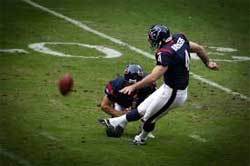How Many Points Is A Touchdown Worth In Fantasy Football
In a standard league, the eight players on a team's active roster earn points based on the statistics they generate in actual NFL games. These fantasy points are added together for a weekly team score. Statistics from bench players do NOT earn fantasy points. The winner of an fantasy football game is the team with more points earned for the week (two weeks for playoff games). In the event that both you and your opponent accumulate the same number of points, a tie will be awarded. No playoff game can end in a tie (see the Playoffs page for more information).
- How Many Points Is A Field Goal Worth In Fantasy Football
- How Many Points Is A Touchdown Worth In Fantasy Football
- How Many Points Is A Touchdown Worth In Fantasy Football Score
- How Many Points Is A Touchdown Worth In Fantasy Footballers
Each passing touchdown is worth 4 points while rushing and receiving touchdowns are worth 6 points each. Receptions are each worth 1 point. For example, if a wide receiver catches 5 passes for 52 yards and a touchdown, he will have 16.2 fantasy points. Kicker Scoring For Apex Fantasy Football Leagues. A touchdown is worth six points, except in the defunct WFL where it was worth seven points. For statistical purposes, the player who advances the ball into or catches it in the end zone is credited with the touchdown. If a forward pass was thrown on the play, the throwing player is credited with a passing touchdown. Field goal (3 points).
Offense:
Quarterbacks (QB), Running Backs (RB), Wide Receivers (WR), Tight Ends (TE)
6 pts per rushing or receiving TD
6 pts for player returning kick/punt for TD
6 pts for player returning or recovering a fumble for TD
4 pts per passing TD
2 pts per rushing or receiving 2 pt conversion (note: teams do not receive points
for yardage gained during the conversion)
2 pts per passing 2 pt conversion
1 pt per 10 yards rushing or receiving
1 pt per 25 yards passing
Bonus Points
2 pts per rushing or receiving TD of 40 yards or more
2 pts per passing TD of 40 yards or more
(note: the player must score a touchdown to score the points)
Penalty Points
-2 pts per intercepted pass
-2 pts per fumble lost
Kickers (K)
5 pts per 50+ yard FG made
4 pts per 40-49 yard FG made
3 pts per FG made, 39 yards or less
2 pts per rushing, passing, or receiving 2 pt conversion
1 pt per Extra Point made
Penalty Points
-2 pts per missed FG (0-39 yds)
-1 pt per missed FG (40-49 yds)
(note: a missed FG includes any attempt that is blocked, deflected, etc.)
Defensive/Special Teams (D)
| 10 | pts for 0 points allowed |
| 7 | pts for 2-6 points allowed |
| 4 | pts for 7-13 points allowed |
| 1 | pt for 14-17 points allowed |
| 0 | pts for 18-21 points allowed (note: team defense is responsible for all points allowed) |
| -1 | pts for 22-27 points allowed |
| -4 | pts for 28-34 points allowed |
| -7 | pts for 35-45 points allowed |
| -10 | pts for 46+ points allowed |
3 pts per defensive or special teams TD
2 pts per interception
2 pts per fumble recovery (Note: includes a fumble by the opposing team out of the end zone)
2 pts per blocked punt, PAT, or FG (Note: a deflected kick of any kind does not receive points)
2 pts per safety
1 pt per sack
“ESPN’s fantasy football projections are way off. They'reprojecting Kelvin Benjamin will score 18.4 points in my league. He's only scoredover 18 points twice, and one of those times was 18.2 points. He averages 13points a game. How do they come up with this stuff?!“
That was something I casually said at work one day before week 9.
At Datascope, these kind of statements (and others) sparkfierce debate and quickly escalate into bets. As soon as the words left mymouth, Dean wasthere, right hand extended; a six-pack bet was on the table.
Dean believed that ESPN's projections are, on average, accurate —that the difference between ESPN's projected scores and actual scores is notsignificantly different than zero. I didn’t have a strong enough opinionto bet, but Mike couldn’tpass up another opportunity to beat Dean, so he took it.
How Many Points Is A Field Goal Worth In Fantasy Football



Given that fantasy football championships are near, it seemed like a funquestion to answer - how accurate are ESPN’s weekly projections?Thankfully, ESPN has pages for theirhistoricalprojections and weekly scoring. Mix in a little code, andwe're able to answer the question pretty easily.
Here’s what things look like through week 14:
Above is the distribution of absolute errors for all players ESPN projectedto score at least one point.[1] Negative values mean ESPN under-projected,positive values mean they over-projected. Based on this, it looks like ESPNmight over-project slightly, but that distribution is pretty close tobeing centered around zero. To determine whether the projections really arebiased, we need to test for statisticalsignificance.
The chart above shows a bootstrapped estimate of the mean absolute error.With bootstrapping,we create many simulations of our observed data by randomly sampling from it(with replacement). For each simulation, we take the mean of the absoluteerrors. The resulting distribution (above) is the standard error of the mean,in this case giving us a 95% confidenceinterval of 0.34 +/- 0.2. If zero were to fall within our 95%confidence interval, we would say that ESPN’s projections are, onaverage, indistinguishable from zero.
We probably don’t care about all projections though. In mostfantasy football leagues, only about 180 players are “owned” at agiven time. For the purposes of the bet, we really care about “fantasyrelevant” players; that is, players where the projection is relevant todetermining who you sit or start.[2]
The first chart shows the absolute error distribution for fantasy relevantplayers, while the second shows the standard error of the mean for thatdistribution (again using bootstrapping). We can see that the standard error ofthe mean shifts further to the right, this time with a 95% confidence intervalof 1.40 +/- 0.25.
Whether we look at all players or only fantasy relevant playersdoesn’t change the results. On average, ESPN over-projects.[3]
That settles the bet — ESPN over-projects fantasy football points. Mike wins. Sorry, Dean.
The end? Nope.
A lesson in bias
How Many Points Is A Touchdown Worth In Fantasy Football
While the bet’s officially over, we’ve only looked at theabsolute error — the difference between projected points and actualpoints scored. One issue with this approach is that it doesn’t take theunderlying projection into account.
For instance, imagine MattForte was projected to score 20 points while Ka’DeemCarey (Forte’s backup) was projected to score one point. IfForte scores 19 points and Carey scores zero, both players have an absoluteerror of one point. However, one could argue that the near-miss onForte’s total is more impressive.
An alternative approach would be to look at the relative error, whichnormalizes the absolute error against the prediction.[4] Using the previous example,Forte’s relative error is 5% while Carey’s relative error is100%.
Here’s what things look like if we look at the relative error forfantasy relevant players.
That changes things completely! The first chart shows thedistribution of the relative error, while the second shows the standard error ofthe mean for the relative error. This time, our mean relative error distributionheavily overlaps zero, meaning that ESPN’s projections are accurate.Dean wins!
How Many Points Is A Touchdown Worth In Fantasy Football Score
Wait, what happened?
Above we’ve added a bootstrapped estimate of the medianrelative error.
Looking at all three, the story becomes clear. In the first chart, we seethat the relative error distribution is nearly centered around zero; however,while there’s more mass on the positive side, there are some largenegative values. When we look at the standard error of the mean (center), thelarger negative values cancel out the mass of small positive values, creatinga nice distribution around zero. Nonetheless, in the last chart, we seethe standard error of the median is consistently 0.25 or higher, meaning that half the time, ESPN over-projects by at least 25%.
/cdn.vox-cdn.com/uploads/chorus_image/image/65911973/Week15FantasyOutlook_Getty_Ringer.0.jpg)
Which brings us to an important question: how do we define bias? Well, itdepends on what we want. In this case, the average relative error ofESPN’s projections is indistinguishable from zero, but ESPN over-projects 60% of the time!
This shows the importance of knowing the underlying distribution of yourdata. Since fantasy scoring is not normally distributed, one could argue thatthe mean should not be used due to the long tail of thedistribution making the mean a poor measure of the center. Depending on youruse-case, the median might be better suited.
[1]( text{Absolute error}= left( text{projected fantasy points} - text{actual fantasy points scored} right) )
[2] We defined“fantasy relevant” as each week’s top 20 projected QBs, 60RBs, 60 WRs, 20 TEs, 15 Ks, and 15 D/ST. Assuming a 10 team, standard rosterleague, we felt these were the players that really mattered forprojections.
[4]$$text{Relative error}=frac{text{projected fantasy points} - text{actual fantasy points scored}}{text{projected fantasy points}}$$